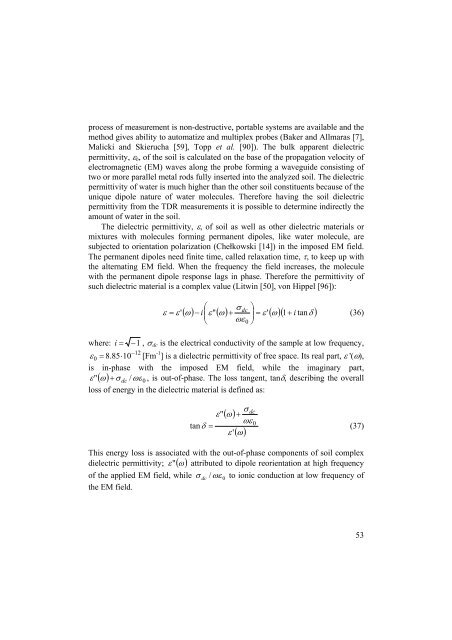ekS - Instytut Agrofizyki im. Bohdana DobrzaÅskiego PAN w Lublinie ...
ekS - Instytut Agrofizyki im. Bohdana DobrzaÅskiego PAN w Lublinie ...
ekS - Instytut Agrofizyki im. Bohdana DobrzaÅskiego PAN w Lublinie ...
You also want an ePaper? Increase the reach of your titles
YUMPU automatically turns print PDFs into web optimized ePapers that Google loves.
process of measurement is non-destructive, portable systems are available and the<br />
method gives ability to automatize and multiplex probes (Baker and Allmaras [7],<br />
Malicki and Skierucha [59], Topp et al. [90]). The bulk apparent dielectric<br />
permittivity, ε b , of the soil is calculated on the base of the propagation velocity of<br />
electromagnetic (EM) waves along the probe forming a waveguide consisting of<br />
two or more parallel metal rods fully inserted into the analyzed soil. The dielectric<br />
permittivity of water is much higher than the other soil constituents because of the<br />
unique dipole nature of water molecules. Therefore having the soil dielectric<br />
permittivity from the TDR measurements it is possible to determine indirectly the<br />
amount of water in the soil.<br />
The dielectric permittivity, ε, of soil as well as other dielectric materials or<br />
mixtures with molecules forming permanent dipoles, like water molecule, are<br />
subjected to orientation polarization (Chełkowski [14]) in the <strong>im</strong>posed EM field.<br />
The permanent dipoles need finite t<strong>im</strong>e, called relaxation t<strong>im</strong>e, τ, to keep up with<br />
the alternating EM field. When the frequency the field increases, the molecule<br />
with the permanent dipole response lags in phase. Therefore the permittivity of<br />
such dielectric material is a complex value (Litwin [50], von Hippel [96]):<br />
σ<br />
ε ε '( ω) i ⎛<br />
ε"<br />
( ω) dc ⎞<br />
= −<br />
⎜ + = ε '( ω)( 1 tanδ<br />
)<br />
ωε<br />
⎟ + i<br />
(36)<br />
⎝<br />
0 ⎠<br />
where: i = −1<br />
, σ dc is the electrical conductivity of the sample at low frequency,<br />
−12<br />
ε0 = 8.85⋅10<br />
[Fm<br />
-1 ] is a dielectric permittivity of free space. Its real part, ε '(ω),<br />
is in-phase with the <strong>im</strong>posed EM field, while the <strong>im</strong>aginary part,<br />
ε" ( ω) + σ dc / ωε0<br />
, is out-of-phase. The loss tangent, tanδ, describing the overall<br />
loss of energy in the dielectric material is defined as:<br />
σ dc<br />
ε"<br />
( ω)<br />
+<br />
ωε 0<br />
tanδ<br />
= (37)<br />
ε '<br />
( ω)<br />
This energy loss is associated with the out-of-phase components of soil complex<br />
ε" ω attributed to dipole reorientation at high frequency<br />
dielectric permittivity; ( )<br />
of the applied EM field, while σ dc /ωε 0 to ionic conduction at low frequency of<br />
the EM field.<br />
53
















